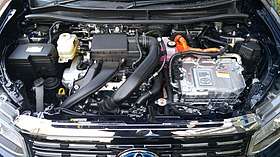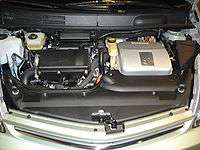Toyota NZ engine
The Toyota NZ engine family is a straight-4 piston engine series. The 1NZ series uses aluminum engine blocks and DOHC cylinder heads. It also uses sequential fuel injection, and has 4 valves per cylinder with VVT-i.
| Toyota NZ engine | |
|---|---|
 | |
| Overview | |
| Manufacturer | Toyota |
| Designer | Yasushi Nouno, Hiroshi Tada, Toshifumi Takaoka[1] |
| Production | 1NZ-FXE: from December 1997[2] 1NZ-FE: from July 1999[3] 1NZ-FXP: from 2017 1NZ-FTE: from 2004 2NZ-FE: from October 1999[4] |
| Layout | |
| Configuration | Naturally aspirated Straight-4 |
| Block material | Aluminium |
| Head material | Aluminium |
| Combustion | |
| Fuel type | Petrol |
| Cooling system | Water-cooled |
| Output | |
| Power output | 74–109 hp (55–81 kW; 75–111 PS) |
| Torque output | 111–141 N⋅m (82–104 lb⋅ft) |
| Chronology | |
| Predecessor | Toyota E engine |
| Successor | Toyota M15A engine (I3, for 1NZ series) |
The engines are produced by Toyota's Kamigo Plant in Toyota, Aichi, Japan (1NZ for Prius, NZ for Vitz and ist, and R1NZ for Sienta);[3] by Siam Toyota Manufacturing in Chonburi, Thailand (NZ for NBC cars such as the 1NZ-FE for the Yaris and Vios);[5][6] and by Indus Motor Company in Karachi, Pakistan (2NZ for Corolla).[5]
1NZ-FXE

The 1NZ-FXE is a hybrid 1.5 L (1,497 cc) version. Bore and stroke is 75 mm × 84.7 mm (2.95 in × 3.33 in). It features forged steel connecting rods and an aluminum intake manifold. The engine has a high physical compression ratio of 13.0:1, but the closing of the inlet valve is delayed, for an effective compression ratio of 9.5:1[7]. The net result is that the engine has a greater effective expansion than compression—making it a simulated Atkinson cycle, rather than a conventional Otto cycle.
The reduction in cylinder charge means reduced torque and power output, but efficiency is increased. This combination makes the 1NZ-FXE suitable for use with the Hybrid Synergy Drive, where peak torque and power demands can be met by the electric motor and battery. Output is 76 hp (57 kW; 77 PS) at 5000 rpm with 115 N⋅m (85 lb⋅ft) of torque at 4000 rpm. Peak thermal efficiency is about 37%.[8] Production was discontinued in 2009, with the arrival of the 3rd generation Prius, which replaced the 1NZ-FXE with the 2ZR-FXE.
In 2012, upon the arrival of the Prius c (North America), the Aqua (Japan), and the Yaris Hybrid (Europe), an improved version was introduced. Without any belt-driven accessories, and a physical compression ratio of 13.4:1, the new version delivers an output of 74 hp (55 kW; 75 PS) at 4800 rpm with 111 N⋅m (82 lb⋅ft) of torque at 3600–4400 rpm.
The 1NZ-FXE Hybrid Synergy Drive in the Toyota Prius has won several International Engine of the Year awards:
- Best Eco-friendly 2000
- Best Eco-friendly 2001
- Best Fuel Economy 2005
- Best 1.4-litre to 1.8-litre 2005[9]
- Best Fuel Economy 2006
- Best 1.4-litre to 1.8-litre 2006[9]
Applications:
- Toyota Prius (XW10 & XW20)
- Toyota Prius c/Toyota Aqua
- Toyota Yaris
- Toyota Corolla (Axio/Fielder)
- Toyota Sienta (2nd generation)
1NZ-FXP

The 1NZ-FXP is a hybrid 1.5 L (1,497 cc) version. Bore and stroke is 75 mm × 84.7 mm (2.95 in × 3.33 in). It features forged steel connecting rods and an aluminum intake manifold. The engine has a high physical compression ratio of 13.0:1, but the closing of the inlet valve is delayed, for an effective compression ratio of 9.5:1[10]. The net result is that the engine has a greater effective expansion than compression—making it a simulated Atkinson cycle, rather than a conventional Otto cycle.
The reduction in cylinder charge means reduced torque and power output, but efficiency is increased. This combination makes the 1NZ-FXP suitable for use with the Hybrid Synergy Drive, where peak torque and power demands can be met by the electric motor, battery and LPG-hybrid system. Output is 76 hp (57 kW; 77 PS) at 5000 rpm with 115 N⋅m (85 lb⋅ft) of torque at 4000 rpm. Peak thermal efficiency is about 37%.[11].
Applications:
- Toyota JPN Taxi (AP10)
1NZ-FE
The 1NZ-FE is a 1.5 L (1,497 cc) conventional Otto-cycle variant of the 1NZ-FXE with VVT-i. The engine block is found in many Toyota models assembled in Japan and Asian countries. It retains the same bore and stroke, but the compression ratio is lowered to 10.5:1. Output is 109 hp (81 kW; 111 PS) at 6000 rpm with 141 N⋅m (104 lb⋅ft) of torque at 4200 rpm. The redline is 6400 rpm.
Applications:
- Toyota Vios/Belta
- Toyota Yaris/Echo
- Scion xA/Toyota ist
- Scion xB (1st generation)/Toyota bB (1st generation)
- Toyota Raum
- Toyota Porte
- Toyota Platz
- Toyota Auris
- Toyota Fun Cargo
- Toyota Premio
- Toyota Allion
- Toyota Corolla (Axio/Fielder, RunX, Allex)
- Toyota Sienta
- WiLL VS
- Toyota Probox
- Toyota Ractis
- Geely CK (Produced under license)
- Geely MK (Produced under license)
- Great Wall C10
1NZ-FTE
The 1NZ-FTE is a 1.5 L (1,497 cc) with an air-to-air intercooler Turbocharged conventional Otto-cycle variant of the 1NZ-FXE with VVT-i. The engine block is found in many Toyota models assembled in Asian countries. It retains the same bore and stroke, but the compression ratio is lowered to 10.5:1. Output is 141–148 hp (105–110 kW; 143–150 PS) at 6000 rpm with 196–200 N⋅m (145–148 lb⋅ft) of torque at 4200-4800 rpm. The redline is 6400 rpm.
Applications:
- Toyota Vios Turbo (Thailand)
- Toyota Vitz RS Turbo (Japan)
- Toyota Corolla Axio GT (Japan)
2NZ-FE
The 2NZ-FE is a 1.3 L (1,299 cc) version. Bore and stroke is 75 mm × 73.5 mm (2.95 in × 2.89 in), with a compression ratio of 10.5:1. Output is 63 kW (84 hp; 86 PS) at 6000 rpm with 121 N⋅m (89 lb⋅ft) of torque at 4400 rpm. In 2000, it won the International Engine of the Year award in the 1-litre to 1.4-litre category.[12]
Applications:
- Toyota Yaris/Echo/Vitz
- Toyota Vios/Belta
- Toyota Platz
- Toyota Porte
- Toyota Corolla (E140), Pakistan only
- Toyota Corolla (E170), Pakistan only
- Toyota bB
- Toyota Ist
- Toyota Corolla (E120), Japan and Middle East only
- Nanjing Yuejin Soyat (based on the SEAT Ibiza Mark I)
See also
References
- Itazaki, Hideshi (1999). The Prius That Shook The World. Tokyo: Nikkan Kogyo Shimbun. p. 147, 150, 160. ISBN 4-526-04376-1.
- "Technical Development: Engines". Toyota Motor Corporation. Archived from the original on January 1, 2001.
- "General Status of Plants in Japan: Kamigo Plant". Toyota Motor Corporation. Archived from the original on August 2, 2013.
- "Toyota Yaris Family Grows With New 1.3-Litre Versions". Toyota (GB). August 2, 1999. Archived from the original on October 22, 2015.
- "Overview of Overseas Production Affiliates: Asia". Toyota Motor Corporation. Archived from the original on December 6, 2012.
- "About STM". Siam Toyota Manufacturing. Archived from the original on February 19, 2014.
- "Car and Driver 2004 Toyota Prius Specs" (PDF).
- "Toyota targeting thermal efficiency of more than 45% for next-generation gasoline engines for hybrids". Green Car Congress. Retrieved 3 May 2015.
- "Archive | International Engine of the Year". Engine Technology International magazine. Retrieved 10 February 2015.
- "Car and Driver 2004 Toyota Prius Specs" (PDF).
- "Toyota targeting thermal efficiency of more than 45% for next-generation gasoline engines for hybrids". Green Car Congress. Retrieved 3 May 2015.
- "1-litre to 1.4-litre: Toyota 1.3-litre VVTi". Engine Technology International. UK & International Press. Archived from the original on July 19, 2001.
External links
| Wikimedia Commons has media related to Toyota NZ engines. |